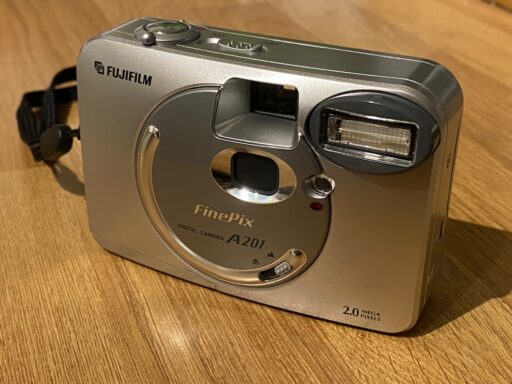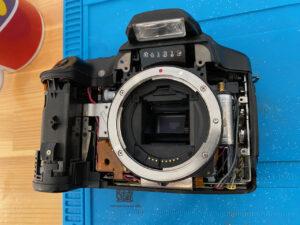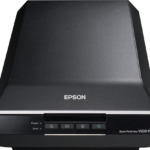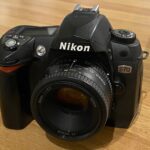A reoccurring theme over at Canny Cameras is the “camera for a quid.” Short of being gifted a camera, which is cheating, a single pound is about the most rock bottom price you could expect to pick up a camera for, but the price isn’t the main motivator here. The real challenge is to see what is the best or most interesting bit of kit you can find for such a restrictive price limit – obviously, postage doesn’t apply!
Initially, it seems easy. You can buy loads of cameras for a quid, but a lot of them are either total junk, fixed focus point and shoots or Canon 1000F’s and I’ve already got a cupboard full of those. Trying to find something which I’ve not already reviewed, owned or has a remotely interesting story to tell is far more difficult than you’d think, especially when you think you’re on to something only to get done over by those people who throw in a bid at the last minute to spoil the party.
Perseverance does eventually pay off, just not in the “I hope I win a Leica that’s been badly listed for a quid” way you imagine…
In this post:
Buy cheap, buy broken
After setting up a very restrictive eBay search I sat back and pressed F5 every few days to see what popped up. I didn’t really want to pick up yet another generic compact digital camera again, but when this popped up it looked at a cursory glance to be at least a little more interesting than a bog standard old compact. I didn’t do any research into the model and despite being listed as “not working” the seller described the only problem being that the memory card wouldn’t stay in the slot any more. For a quid, it’s got to be worth a look, hasn’t it?
Ebay have started to show publicly how many people are watching items you’re looking at in a move to drive you into panic buying or bidding before anyone else gets their hands on your tat. Would it surprise you if I told you that there were a grand total of… zero people interested in this item? No? Oh…

With the recent increase in seller fees, I half expected the seller to just not bother sending it out. I can sympathise, it’s misery enough selling on eBay as it is, but to sell something and make approximately 40p for your effort it hardly makes it worthwhile. Many days passed with no news but eventually they did send the camera out in an actual box too! I half expected another plastic bottle and a roll of parcel tape job… Credit where it’s due.
In yet another eBay first, it turned out to be exactly as described – perfect working order with the exception of an overly excitable card slot that just pinged the card back at you every time it was pushed in. Clearly a clip or retaining tab had broken or stopped working so it was time to dig in and see what’s what.

Looking at it, there was definitely something broken off the side of the card slot, but where it had gone is anyones guess. I did some futile Googling to see if I could find out what the slot should look like to try and guide some kind of fix but left empty handed. A closer inspection revealed that the pins were shaped in such a way that they would grip on to the card themselves if only there wasn’t a spring pushing it out again.
In what must be one of the most delicate repair jobs ever, I carefully tried to remove the metal lid off the card slot so I could take the offending spring out. The whole thing promptly exploded, little bits of plastic flying everywhere. God only knows where the spring got to, but I’d definitely solved the problem – the card now stayed quite firmly in the slot and neither popped out nor fell out. Result! I glued the lid back on for some extra security and screwed the camera back together.
Was it really a pound?

No.
Well, the camera itself was but I didn’t own an xD memory card. Not a problem, you’d think, but have you seen the prices of these things? They’re stupidly expensive. Why? Who are these people demanding xD cards apart from weirdo camera fanatics like me…? The answer I believe is actually rather simple – they weren’t made for very long and relatively few cameras made use of them so now they’re something of a rarity.
I ended up paying, and make sure you’re sitting down for this, £14 for a 64mb memory card.
£14.
Worse still, I’m fairly convinced that my xD card is not at all well. When downloading images from it, there are occasional very long pauses whilst it thinks about things before either refusing entirely or (sometimes) magically waking up again. If you were in any doubt, no, this isn’t normal behaviour.
For the £15 in total I spent on this I probably could’ve bought a roll of Kodak Portra and finally found out what all the hipsters on YouTube are getting excited about, although that would mean I’d have to grow an overly well maintained beard as well and that’s a step too far.
As we’ve learned many, many times on this website, people just don’t remember to delete the contents of old memory cards or remove old films from disused cameras. This one came preloaded with a few pictures of a cat and what must’ve been an eBay listing extravaganza of rather dull furniture and clothing. Nothing exciting or incriminating, but still it does worry me that people have no idea who’s hands their data will end up in or what it could be used for. Also, it goes against what the seller said about it being “fully tested” as it blatantly wasn’t – anyone of sound mind would’ve formatted the card before selling it if they’d have plugged it in to test.
Design and features

The S3500 looks like a really promising bridge type camera. It’s much smaller in real life than it looks in pictures but despite this tiny size it’s very nice to hold. Fujifilm cameras of this era were properly plastic fantastic and as such the build quality feels “ok ish” but gives the camera the benefit of weighing next to nothing. On a long walk, it doesn’t pull your wrist off if you choose to carry it around without a strap.
The £300 launch price in 2004 suggests that nearly all of the budget went on the 6x zoom lens that gives a decent amount of flexibility from wide to telephoto, with nothing left over for anything else. For a camera that looks the part, you get an absolute bum deal in terms of features. You can forget 99% of manual controls with this Fujifilm – thou shalt not control shutter speed, aperture nor ISO. As Willy Wonka once said “You get nothing, good day Sir!”
Inside the sparse menus you can set the image quality and do some basic exposure compensation but that’s really it. Then there’s the party piece – an electronic viewfinder. I suppose an optical viewfinder would’ve added more to the bill of materials and potentially increased the size of the camera. Having the EVF is quite a boon though as the LCD screen is next to useless in anything like bright sunlight. This gives you a much better shooting experience than trying to shield the screen and frame up a shot at the same time.

That’s where the good news ends, though. The EVF is of such low resolution and the pixels so visibly large that at times it looks like you’re viewing an image made up of really colourful bricks. It’s slow to update, which doesn’t really matter in most circumstances and, incredibly, it doesn’t give you an accurate representation of the final shot. How it’s possible to make an EVF that doesn’t show 100% of the final image is really quite something, but Fujifilm managed it here. Every picture you take that you framed to be a really tight crop comes out of the memory card with a load of extra information around the sides. Excellent.
In use

Having used quite a few old digital cameras recently I’ve noticed that they all share a similar look and feel to the image. It’s hard to put into words, but it is more than possible to look at an image and go “yep, 2000’s digital camera.” Modern digital cameras, especially those in phones, apply more processing to the image than could ever have been imagined in 2004 and so tend to produce images that are richer in detail and have fewer problems with tricky lighting conditions.
One thing that makes these early digital cameras stand out isn’t so much the low resolution (which you don’t really notice unless you zoom in) but the total lack of dynamic range compared to modern cameras. Any scene with more than an average amount of contrast will result in either muddy shadows or, more usually, totally blown out highlights. We have come a long way with digital imaging and dynamic range is definitely one of the biggest areas of improvement.
That said, the S3500 is capable of producing some quite pleasing images. That it records only JPG’s is definitely a huge drawback, but raw files were never going to be an option with the stripped down feature set on offer here. Focus was relatively accurate if not a little slow and the time to record each image was acceptable by 2004 standards. I made extensive, almost exclusive, use of the EVF and despite its weaknesses I really did enjoy using it.

Personally, I found the strength of this camera to be in its macro mode. Although not spectacular, it does allow you to get very close to a subject and, as the shot of a dragon fly above shows, you get a reasonable amount of detail if you’re careful and take your time to find the absolute limit of the close focus distance.
The same positivity cannot be expressed about the 6x zoom lens, however. Useful though it undoubtedly is, there’s something off with the metering at the telephoto end of the lens. I saw a heron land by a local river and knew it’d be a good opportunity to show the useful nature of having a decent amount of zoom available. Not being able to adjust the ISO at all, the first problem is that the camera warns of camera shake even in excellent lighting conditions outdoors. I rested the camera on a solid wall, held still and took a couple of frames. This is what came out:

This is not a difficult scene for any camera to meter correctly. What in Gods name has happened here? The white of the Heron has completely fooled the meter and the camera has blown out all detail in the bird. The picture is overexposed and this was the case for multiple shots, not just a chance one off mistake. The picture above is not a crop either and you can see that, when zoomed in, there’s plenty of chromatic aberrations and edge softness to boot. This is definitely in the “not great” category of performance by both lens and camera.
A single set of 4 AA batteries provided more than enough run time, although I did make sure to turn the camera off between each shot having experienced the battery eating monster that is the Fujifilm A201 I thought best to not leave this one to chance. Talking of powering on the camera, the switch is around the shutter button and is relatively easy to accidentally knock between modes – the first of which is playback. I know you could argue either way, but personally I would suggest that its more important to be able to quickly get into shooting mode than it is playback and perhaps these should’ve been reversed. It also makes little sense that the camera effectively has two control dials – the functions could easily have been combined into the mode selector and this probably would’ve made more ergonomic sense.
Conclusions and learning

What, if anything, can we learn from a 20 year old £1 bargain basement digital camera?
Well, the first thing is that it is perfectly possible to pick up a usable (after some bodging) camera that takes some reasonable pictures for a quid. Should you bother? Of course not. We all know the main conclusion here – your smartphone camera far outperforms cameras like this and is orders of magnitude more convenient not only in that it is always in your pocket but consumes next to no power.
Or is that really the case? In terms of resolution, of course – yes. Modern phones do out perform old digitals, but the gap at the cheap end of the market is starting to close. Forget the headline figures of 48mp for flagship phones, they really do not do that resolution justice at all and cheap digital cameras around 10mp are starting to fall into pocket money territory on the second hand market. What’s the point here?
The point is physics – smartphone cameras are constrained by their tiny lenses (have you noticed how much they’ve grown over the years?) and equally tiny sensors. Larger lenses, especially those which have been well designed and larger sensors will give you better performance than a current smartphone camera ever can. Yes, you might need to do some work on the images that come out of a dedicated digital camera, but those impressive smartphone images have seen some serious tweaking in both hardware and software to get to the finished article you see on screen.
Am I really suggesting you abandon your smartphone for a £1 digital camera? Of course not, but I am saying there comes a point when cheap digitals become quite compelling again in terms of image quality – although I acknowledge that the undeniable convenience of that smartphone camera will always be hard, if not impossible to beat. But… If you can get your hands on a “proper” bridge camera that gives more manual control than the S3500 and provides RAW files, you really are on to something of a winner.
The S3500 looks the part and I imagine its intended purpose was to be a great little cheap holiday camera. For that purpose it probably did the job nicely, but it really is such a let down in many areas. The zoom lens is great, but has odd quirks when zoomed in. The EVF is a great idea, but performs poorly and doesn’t even give 100% viewfinder coverage. Then there’s the total lack of options and control. Even for a camera “of its day” it is poor and you can totally forget about action shots as the AF can’t keep up and without an ISO much higher than 200 you’re not going to be freezing anything with high shutter speeds!
But lets be fair – this camera cost one whole pound and for that price, can you really complain? No.
Is it worth it?
Nah…!
Share this post:








